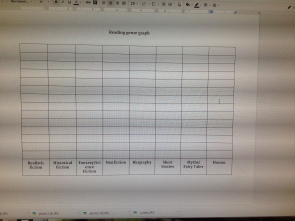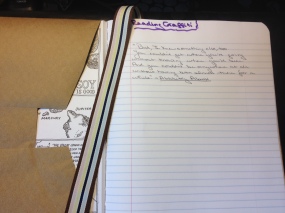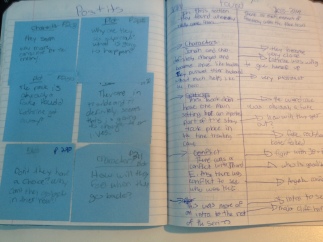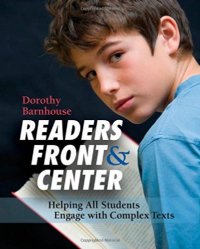Ever since I began teaching, my students’ reading journals have been as much “the gateway to all the work we will be doing from September to June” (to borrow a phrase from a post I wrote about writing notebooks) in reading workshop, as their writing journals are in writing workshop. On the first day of school, after I’ve sent my kids home to complete their reading and writing surveys for their first assignment, my homework is to cover all my students’ new reading journals (college ruled composition books) in sturdy brown paper, so as to ensure that they will survive the workout they receive day in and day out; for our reading journals serve as a repository for all the thinking and responding work that goes into meaningful reading. This year, as part of my continuing journey as a teacher who practices what she teaches, I am going to keep a reading journal myself:
- What our reading journals look like:
We organize these notebooks (on average, my students fill two notebooks with their reading-thinking over the course of the year) in the same way as our writer’s notebooks: minilessons in the back, and journal entries in the front. We also save pages (dogeared together and tabbed) for:
- our running lists of “books I just HAVE to read!” so we are never without reading plans
- a new section this year, borrowed from Donalyn Millers Reading in the Wild, the genre requirements tally chart (pgs. 192 – 193). Here’s what Donalyn has to say about the merits of this important practice: “The genre requirements graph helps students identify their preferences and areas of growth by documenting their reading choices over time. Recognizing their reading preferences helps them develop an accurate portrait of themselves as readers with specific likes and dislikes…These preferences provide a foundation for building reading relationships and offer insights into students’ needs…”. I will be using Donalyn’s version of the chart (because, why mess with genius?!):
- the first page is also new and borrowed from Donalyn – a personal reading graffiti (pgs 113 – 116) collection of memorable quotes from the books we read. This will be a more personal version of our class Reading Graffiti Wall. Here’s mine with the quote I so loved from Lisa Graff’s Absolutely Almost (our first read aloud of the year!):
- a list of ideas about what to write about in our reading letters
- a ribbon to mark where we are/what we want to reference (a particular mini lesson, for instance)
- (More importantly) What “reading work” goes in our reading journals:
Reading response letters:
These are, of course, taken directly from Nancie Atwell’s In The Middle – one of my key go to texts for all things to do with reading and writing workshop, who described the value of these letters this way:
“Each year of letters about books teaches me about adolescent readers – their needs, concerns, and tastes. I learn the value of inviting kids to read as real readers do…and I learn how to respond to what readers are trying to do…Through our correspondence my students learn, too, about the worlds of writing and literature – what good writers do, what good readers do, how readers of literature think and talk, what books are good for, and how kids can get in on it.” (p. 263)
Linda Rief, whose students also keep Writing-Reading-Notebooks, echoes this sense of purpose in her books Seeking Diversity and Read, Write, Teach:
“I believe writing helps them become better readers, and reading helps them become better writers…I believe that talk or writing about some of their reading helps them unfold the layers of significance for them and from the author and that the more they read and talk about their thinking as they read, the more they will discover the craft of writing. The more they read and write, the more they learn about themselves and the world.” (RWT: pg.44)
Although I struggled in the beginning to find a way to adapt this type of correspondence to my sixth graders’ needs and developmental abilities (not to mention my own capacity for reading each of them carefully and writing back just as thoughtfully), it has remained an important aspect of our reading workshop routines. I love receiving these letters, I enjoy writing back, and I value the way it this exchange with my students allows me a personal glimpse into their reading lives – another means of conferring with them, assisting them, assessing their needs and progress, sharing our reading journeys. My students write to me about every other week, and they write to each other during book clubs or genre studies. We create a chart labelled “What can we write about our reading lives?” at the end of our first week of school, and we add onto this as the year progresses and we discover (as a class) how authors create wonderful literature, and how readers make meaning of these stories.
Letters from students reveal so much about them, about how and why they read, and about what they are gleaning from their books. Here is Sophie, doing exactly this:
“Now that I am getting to the end of the series, I have been getting a really strong sense of the author’s message. Burned has many messages, really, but the one that really popped out to ME was the fact that you have to believe in something you really care about and work at it. This is important in life, because sometimes you need to ignore what other people think is true for you and kinda create your own truth. Meaning, you have to think outside the box and figure out your own truths. Right? Does that make sense to you?”
Or Sarah, writing about two characters in Endymion Spring:
“I’m not sure why, but I like Julian. I think that he and Blake have some sort of connection or partnership. What I mean by this is a special originally-made connection, this is how I choose my mitt for softball. My dad thinks it’s stupid, but I choose my mitt if we can work together as one. That’s how I think Blake and Julian are. They connect to each other and work together better, just like my mitt and I are one on the field – a connected to each other team.”
And Sam, working through some issues in his book, The Sight:
“I’m just starting to really get into this book because I finally figured out how to deal with something SO ANNOYING about it. The creatures in this book have their own language, and they use words but don’t say what they mean. You have to figure it out each time. Like drappa for girl and dragga for boy. So, I was always like “huh? what’s he even talking about?” But now that figured out how to look for clues, I made a bookmark with all of them. Like my own glossary. IMHO, the author should have done that. But, anyways, I figured it out so I’m good with the series from here on.”
I never ask for summaries of books my students are reading anymore, since (as one of them informed me some time ago) “It’s really easy to get them from Amazon or Goodreads – it’s like there and done for you, you know.” Right. Sixth graders are nothing if not honest.
And I always write back. There is nothing more pointless than a reading journal (and I have seen many of these) filled with letters from students responded to this way: “Great reading!” “ Good points!” “ Check +!” What is the point of this? And what a waste of (what could be instead) precious reading time!
Book Club Notes:
My students gather notes as they read and discuss their books, and their reading journals become a place to collect their thinking, write about their ideas, and use for reference when we write literary essays. These are messy, work-in-progress pages which reflect how thinking changes as we discuss the books we read:
A selection of choice in reading responses:
I wrote a post about this here at Two Writing Teachers, which reflected a change in my thinking about the format of reading responses. Our kids benefit from choice, and their responses are more authentic when they can find methods that truly reflect their thinking. This point was driven home for me this summer when I tutored a few rising 7th. graders, all of whom felt that the one thing they hated most about reading was – the reading response assignment: it was always the same format, and no one ever really read it. Point taken. We trade notebooks, and have gallery walks to help make this process a shared learning experience.
New pathways to deepen our understanding of reading:
I am always discovering new ways of doing this, thanks to the amazing educators who research and write books and blogs to illuminate the path. For example, Kate Roberts wrote a brilliant post : The Five Corners of the Text: Close Reading and Personal Experience that got my wheels spinning, as did just about every post by Vicki Vinton (here’s one I keep returning to). We experiment with making great ideas about reading visible in our reading journals – it’s messy work, and sometimes we get nowhere – but that’s the way real learning goes.
Two books that gave me much to think about and which I will be writing more about once the school year gets underway are:
I think every reading teacher needs to read these books…asap! As for me, I am thinking through ways in which to weave Vicki and Dorothy’s amazing work into reading workshop this year, work that we will make visible in our reading journals as well.
So there you have it: the life and times of reading journals in Room 202. Some years ago, our kindly custodian mistook the pile of reading journals I had stacked by my desk for trash…so out they went. The next morning, when my distraught kids and I had figured out what had happened, we went dumpster diving and retrieved them all – slightly soiled and slightly smelly, but oh what a relief to have them (and all the work they represented) back in our hands again; our reading journals are important enough to warrant search and rescue missions!
Please share how you write about reading in your reading workshops – we’d love to learn about it.








Hi, Tara!
I absolutely loved this post. I am in my first year of trying reading and writing workshop after going to the TCRWP for a most inspiring summer institute for writing workshop.
I am beginning the year with a focus on building a reading life, and I wondered if you had suggestions for your chart “What Can We Write About Our Reading Lives” that could get me started? We have spent the past two weeks finding books, book talking, finding our reading rates, and just reading. But now I am ready to have the students write about their reading in their notebooks. How do you begin this process? I love your idea of literary letters, but what are some of the first things you have your students write in their notebooks? And how often as well?
Thank you so much!
Katherine Miller
LikeLike
Wow! I just love this post! I am filled with ideas and ready to revive my own reading notebook for the new year!
LikeLike
Tara,
This post is so beautiful and provides much food for thought for teachers considering the similarities and differences between “readers’ notebooks” and “writers’ notebooks”. Your thoughtfulness in carefully constructing this post and including the whys – from your many experts are so helpful!
LikeLike
Great post. Thanks. Question: I love the information I get about student readers through notebooks, but do you also grade them?
LikeLike
I loved this post, Tara! I love reading my students’ reading journals so much, and this post reminded me why! Helping to spark their passions and ideas about reading is so important. Not only is your approach to reading journals fresh and student-centered, it also fosters joy for reading. Who wouldn’t want to have a graffiti wall, letters from their teacher, and lists of must-have books? I feel so inspired! Thank you!
LikeLike
I love being reminded of Nancie Atwell’s and Linda Rief’s wise words (and am honored to be in their company), but it’s the kids’ writing that’s so wonderful.
I’m reminded of asking a class of 5th graders which they liked more, their reading or their writing notebook, and virtually everyone said they preferred their writing notebook, because it felt more like their. The reading notebooks, on the other hand, felt more like they were for the teacher. Sophie, Sarah & Sam all seem to be fully owning their notebooks and using it not just to think about what they’re reading but about themselves, which is always the ultimate payoff. Truly inspiring!
LikeLike
Thank you, Tara, for this comprehensive post. I’ve been thinking a lot today about how to strengthen comprehension instruction so that kids “grow and develop new ideas and insight,” as Dorothy & Vicki so succinctly describe it in What Readers Really Do. Your thoughts have helped me frame ideas to share with my colleagues on how we can make reading journals work for our students. Looking forward to another year of learning with you!
LikeLike
I love the idea of a gallery walk of reading journals – I will have to try that this year. I have done reading letters as well and find them so valuable. Thank you for the resources in this post – I will be checking them out directly!
LikeLike
Why do you keep different notebooks for reading and writing? I’m thinking about my work ( and my personal life) and my writing reflects my reading…
LikeLike
I borrowed the genre chart from Donalyn this year. I am also doing Nanci Atwell’s letter response. Third, my students are posting on our blog on Mondays for It’s Monday: What are you Reading? This is a way they can share what they are reading. My struggle is to differentiate for younger students. They want to write everything about the book. I’ll show them the models of student responses you have in this post. Any other ideas for getting them to write less of a summary and more about their own thoughts? Aimee Buckner has been a big help for this problem. I need to get the last two books you recommended. There is always so much to read!
LikeLike
Wonderful post! I’m launching 8th grade Reading NBs on Tuesday. Love the graffiti wall–I think my students will too. I read Read, Write, Teach over the summer–great resource! Thanks for all the great ideas, Tara!
LikeLike
I can’t imagine that the journals went to the dumpster,Tara. Oh my, & oh no! This is such an all-encompassing post. I’m not sure I can get to those final two pd posts yet, but will keep them in mind. Thank you for being so clear in how you do, what you do, & why!!
LikeLike
Oh my goodness, Tara! I got a sick feeling in my stomach when I read about the custodian and your reading journals! So glad you were able to retrieve them!
This is a great post, as usual. What resources do you recommend for getting started using post-its/stickies?
LikeLike
Tara, this is a wonderful post. So thoughtful and so helpful! I know just the teacher I’m going to send this to — her and I were just having this conversation and it’s like you wrote this just for her! Thank you!
LikeLike
Hmmm…..i was going to have my kids do theirs in duo- tangs this year. Now I am reconsidering. Hmmm,….
LikeLike
Reblogged this on McCarthy of Hudson and commented:
We have had many discussions about Reader’s Notebooks, both as classroom teachers and with classroom teachers in my role as a coach. I appreciate so many of Tara’s ideas that are able to incorporate easily into whatever capacity you use Reader’s Notebooks in your classroom. I am off to investigate Dorothy Barnhouse’s books readers.
LikeLike
Thanks for writing this, Tara! You’ve, as usual, given me more to think about! I’d like our 3rd and 4th grade teachers to start using readers notebooks more but they aren’t quite ready for that. It’s a conversation I will be having with them later this fall!
LikeLike
Thank you. This post is jam-packed with great suggestions for my grade 6 Literacy classes. It has helped me to rethink how I want my students to set up their journal this year. Love the section for great quotes (Book Graffitti) and “books I just HAVE to read”.
LikeLike
Love this post Tara! You make your thinking and rational so clear. I can’t wait to try some of these ideas out with my students.
LikeLike
Great details!! My students have had choice in their reading response journals for years… Beautiful learning happens through writing!! Pne question… Why do you wrap composition books in brown paper… Just wondering! 🙂
LikeLike
What a great and inspiring post. The focus on reading and reflecting in your classroom is clear as a bell and strong enough to warrant “dumpster diving.” A powerful reminder that writing about and reflecting on our reading is what makes it “ours.”
LikeLike